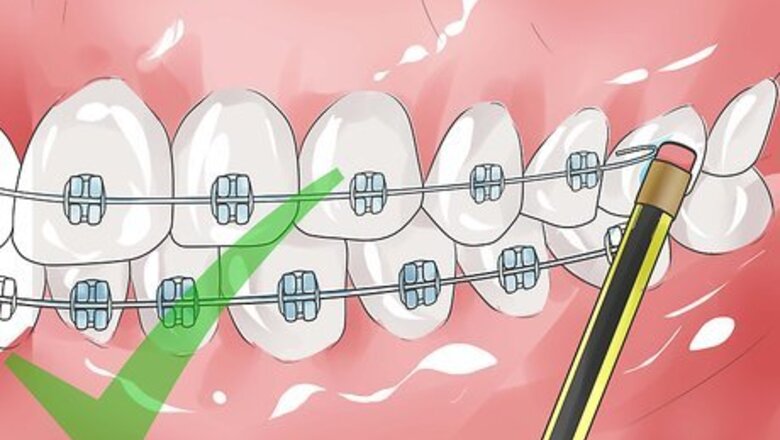
views
Fixing a Poking Wire
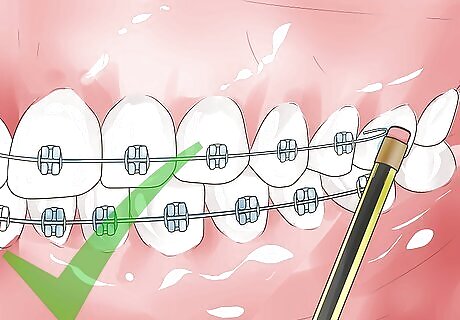
Try to bend thinner poking wires using the eraser end of a pencil. You won't be able to fix all poking wires this way, but this method will help in many cases. Find the wire in your mouth that is poking you. If it is a thin wire, get a pencil with a clean eraser. Gently touch the eraser to the poking wire. Push the wire gently to bend it. Try to tuck the poking wire behind the archwire, or the wire that connects the brackets together. Add wax on top of the wire to keep it in place. Only do this for thinner, more flexible wires.
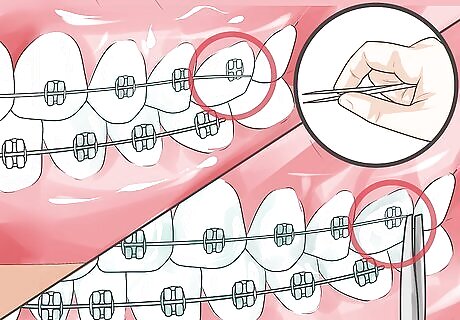
Use tweezers or clippers to fix poking wires in the back of your mouth. Sometimes, eating hard foods can cause flexible wires in the back of your mouth to slip out of the bracket slots on the back teeth. If a wire slips off a bracket, you can try to fix it with tweezers. Dentist Jeremy Silverman also shares, "with small wire clippers or nail clippers, you can also safely snip the offending wire." Get a small pair of thin-nosed tweezers. Make sure to sterilize them with rubbing alcohol before using them in your mouth. Grab the end of the poking or loose wire with the tweezers. Guide it back into the slot on the bracket. Place orthodontic wax on top of the wire to keep it in place. If you can't get the wire back into the slot, you will need to call your orthodontist.
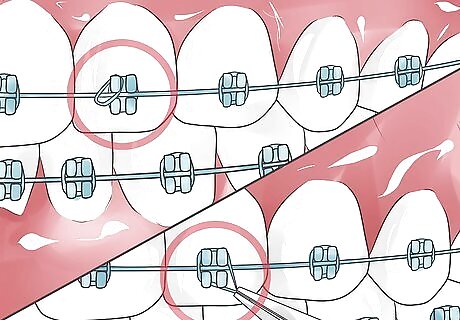
Fix ligatures and wire lace ties that poke your lips using tweezers. Ligatures are the wire or rubber bands that wrap around each bracket, while lace ties are thin wires that wrap around the bracket or archwire. After fixing either piece, you will need to see your orthodontist to follow up for a replacement. Use sterile tweezers to grab a broken ligature and place it back around the bracket. Or, completely remove it if it won’t go back on. If the wire lacing of your braces is broken in the front of your mouth, you can try to tuck the broken lace behind the archwire or around a bracket using tweezers. Or, use the tweezers to bend the wire away from your lips and cheeks. Put orthodontic wax on top of the ligature or wire to hold it in place. If the lace is on top of the archwire you can also remove it by asking a family member to cut it with pliers or wire clippers. This is only recommended as a last option and should be followed by a visit to the orthodontist as soon as possible.
Using Orthodontic Wax
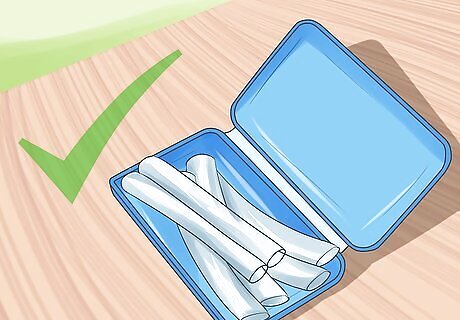
Get some orthodontic wax. Dentist Jeremy Silverman emphasizes that "orthodontic wax placed over the sharp area will provide relief." Your orthodontist should have supplied you with some when you got your braces. If you have run out, you can buy orthodontic wax at most pharmacies. Orthodontic wax comes in small cases containing long strips of wax. If you cannot find wax at a pharmacy, call your orthodontist for some.

Remove a small amount of wax from one of the wax strips. As dentist Jeremy Silverman advises, "be sure to wash your hands thoroughly and brush your teeth prior to applying the orthodontic wax. Pinch a pea-sized amount between the thumb and forefinger and roll the wax into a ball. It can be flattened slightly to cover more area if needed." Make sure your hands are clean and dry before touching the wax. Use only new, unused wax on your braces.

Make sure the wire or bracket that is poking you is dry and clean. It can help to brush your teeth carefully to remove any food or debris from the wires, before applying wax. To dry your braces, hold your lips or cheeks away from the area with poking wires. Let it air dry for a few seconds or use sterile gauze and place it between the brackets and the inside surface of your lip to dry.
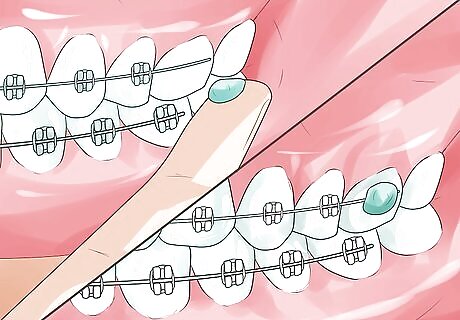
Apply the orthodontic wax ball to the poking wire. All you have to do is press it onto the offending area. Dentist Jeremy Silverman shares that, "your tongue can be used to make slight adjustments if needed." Put the ball of wax on your fingertip. Touch the wax to the poking wire or bracket. Press down gently to cover the wire. Pressure on your teeth or braces while receiving orthodontic treatment can cause some discomfort. If you feel soreness while pressing on the wire, this is completely normal.
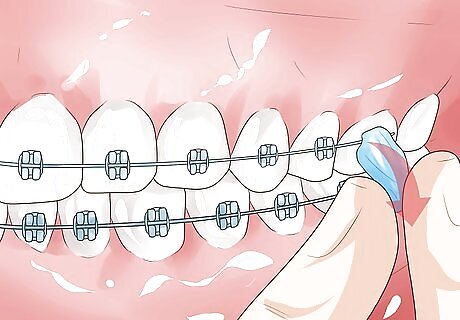
Remove the wax before eating or brushing your teeth. You don't want the wax to get into your food while you eat. Discard any used wax immediately. Replace it with new wax after eating or brushing your teeth. Continue to use the wax until you can see your orthodontist or dentist to fix the wire. If you do happen to swallow the wax, that's okay. It won't harm you.
Treating Cuts and Sores
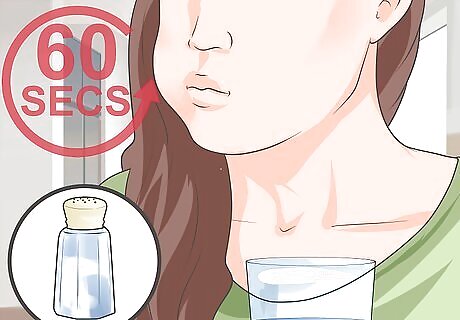
Use a salt rinse to clean your mouth. This can help to treat any sores or cuts caused by poking wires. Dissolve 1 teaspoon (5.7 g) of salt in ½ cup (118 ml) of warm water. Use this as a mouthwash by swishing around your mouth for 60 seconds. This may sting at first, but it will help to relieve prolonged discomfort and prevent infection. Repeat this 4 to 6 times a day.
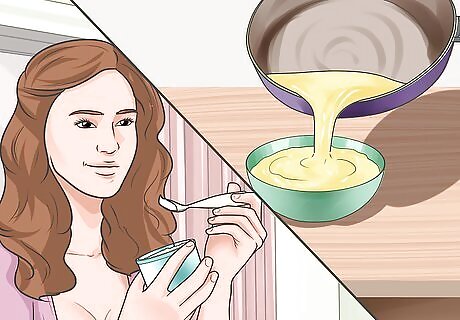
Avoid foods and drinks that are acidic, sugary, or hard to eat. These foods and drinks can damage your braces and potentially lead to poking wires. Instead, eat a soft, bland diet. Eat foods such as mashed potatoes, yogurt, and soups. Avoid coffee, spicy foods, chocolate, citrus fruits or juices, nuts, seeds, and tomatoes. These foods are high in acid and can aggravate any sores or cuts from your wires.

Drink cold water or iced tea. Cold (unsweetened) beverages can help ease the pain from sores. Use a straw to sip a cold drink, taking care not to scrape the cut or sore. You can also eat popsicles to apply cold to the sore. Alternatively, suck on an ice cube. Let the ice sit on the cut or sore for a few seconds at a time.
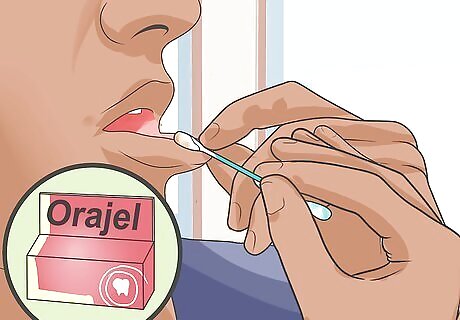
Put an oral anesthetic gel onto any sores or cuts. According to dentist Jeremy Silverman, "topical oral anesthetics, such as Anbesol or Orajel, can provide some [temporary] relief when rubbed on the more painful areas." You can buy Orajel or Anbesol at most pharmacies. Put a small amount of the gel on the end of a cotton swab. Rub the gel over any sores or cuts in your mouth. You can reapply the gel 3 or 4 times each day.




















Comments
0 comment